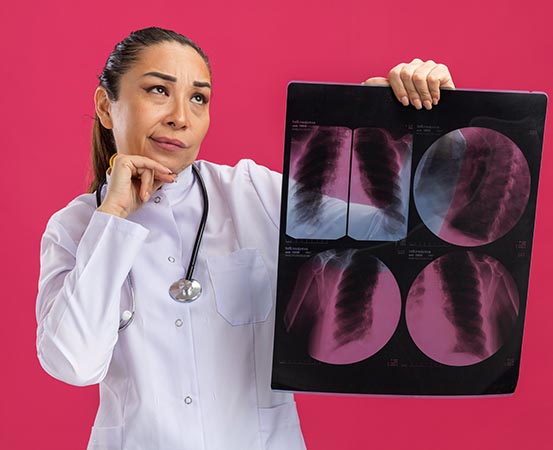
While lung diseases produce symptoms that affect respiratory tract, sometimes, subtle changes in your skin can also indicate an underlying respiratory disease. A discolouration of the skin or a simple skin lesion, for instance, can sometimes be a sign of a serious underlying condition involving your lungs.
Dr Kishan Srikanth, consultant pulmonologist and sleep medicine specialist, KIMS Hospital, Hyderabad says that the skin can act as a mirror to many underlying lung diseases.
Dr Jayalakshmi TK, consultant, pulmonology, Apollo Hospitals, Navi Mumbai says that one example of a condition where lungs and skin symptoms coexist is tuberculosis, a respiratory condition that commonly causes skin lesions. “It can also produce nodules on the skin,” she says.
Dr Jayalakshmi said, “Pulmonary sarcoidosis, a rare condition in which lumps form in the lungs, can also produce skin nodules. These skin nodules usually appear in the shin area- in front of the knee, below the knee etc. It can be swollen and very painful. Those with lung cancer can also develop some skin lesions. This could be dermatitis, itching, dryness of the skin, some nodules in the skin.” Meanwhile, psoriasis, a condition in which itchy rashes form on the skin, is often associated with Interstitial Lung Disease (ILD) and even lung fibrosis (scarring of the lungs), Dr Jayalakshmi added.
How are your lungs and skin connected?
Dr Vamsi Krishna Mutnuri, consultant interventional pulmonologist, Yashoda Hospitals, Hyderabad says that lungs and skin often overlap when it comes to symptoms of allergies.
“Someone with, say, asthma may also have atopic dermatitis (a condition in which the skin becomes itchy, red and inflamed). It is not uncommon to see asthmatic people with skin lesions, especially on the lower limbs, where there is hyperpigmentation, or blackish discoloration of the skin on the extremities. This type of skin lesions combined with asthma, can be a case of atopic dermatitis and we usually refer them to a dermatologist for further consultation,” says Dr Mutnuri.
He adds that it could also work the other way around. A person with skin lesions could consult a dermatologist who might discover that the person has shortness of breath, cough and wheezing. “In such a case, the doctor would refer the patient to a pulmonologist for further examination,” Dr Mutnuri explains.
Symptoms of lung diseases on the skin
A 70-year-old man at a Hyderabad hospital recently complained of shortness of breath while walking and mild exertion. Although he had been experiencing breathing difficulties for nearly two years, he chalked it up to signs of ageing and weight gain.
“People often look for reasons to substantiate their symptoms. This was one such case. He finally decided to visit a pulmonologist after his symptoms worsened over a six-month period and he began struggling to get even his daily tasks done,” says Dr Mutnuri.
Dr Mutnuri says that whenever someone complains of long-term breathlessness, one of the first things to do is check their nails. “When this man walked in, the first thing I noticed were his nails – the fingertips appeared enlarged or bulbous and the nail’s normal angle with the nail bed appears distorted – this is known as nail clubbing and is a clear sign of an underlying lung disease,” he tells Happiest Health.
Doctors decided to check the man’s baseline oxygen saturation level, which was lower than the ideal level for a 70-year-old. “It was around 82 or 84 when it ideally should be above 94,” he says. “We conducted a routine examination and detected signs of lung fibrosis through the stethoscope. We suspected Idiopathic Pulmonary Fibrosis or IPF (scarring of the lungs) in that patient and we confirmed the diagnosis and started treating him for it,” he adds.
Dr Mutnuri says that another common dermatological sign of an underlying respiratory disease is nails, tongue and lips turning blue. “Nails, lips and tongue turning blue indicate central cyanosis, which means that oxygen level in the blood is very low. In lung diseases, with low oxygen level in blood, the person usually has black or bluish discolouration in the fingers and toes. Any such signs on the nail leads us to suspect that the oxygen level is low. If the person also has shortness of breath, an underlying lung disease is suspected,” he says.
Dr Srikanth lists the following pulmonary diseases that could induce changes on skin.
- Lung abscess (fluid buildup in the lungs) and bronchiectasis (dilation of the bronchi) are two infections of the lungs that can cause clubbing of nails.
- In lung cancer, one can see skin nodules or black swelling and engorged superficial blood vessels on the chest.
- Pulmonary sarcoidosis can cause plaques to appear on one’s face, nose and subcutaneous nodules on the legs.
- Pulmonary vasculitis (a condition in which blood vessels in the lungs become inflamed and get destroyed) can induce oral ulcers and necrotic ulcers (dead tissues) on the legs and hands.
Takeaways
- Your skin and lungs are closely linked. Subtle changes in your skin can indicate an underlying respiratory disease.
- Discolouration of the nails, lips, tongue, nails that appear bulbous with a distorted nail-nail bed angle, skin lesions, nodules, ulcers – all these signs on your skin could be indicative of an underlying respiratory disease.

















